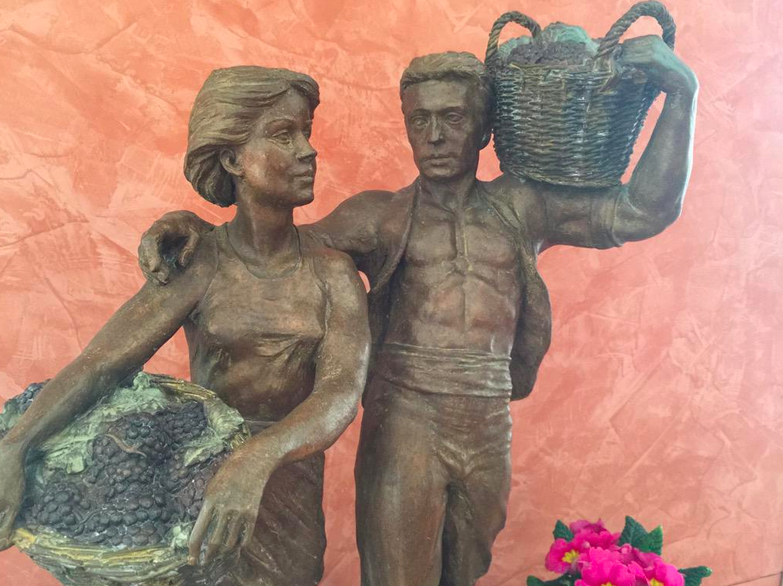by Wine Owners
Posted on 2018-04-19
Wine Owners created proto-prices (first published in this JancisRobinson.com article) to help consumers identify value among en primeur offers. The prices support consumers when buying en primeur, by providing a consistent baseline from which to make purchasing decisions. Confidence in en primeur has been damaged in recent years, by over-inflated release prices and by fraudsters posing as brokers (always check the data, and always check the broker!), so we saw a clear need for a remedy. Each proto-price is the price at which Wine Owners believes a wine should be released in order to make its en primeur offer attractive and worthwhile for the consumer.
©Jonathan Reeve / Wine Owners
Symbiotic EP
En Primeur must be symbiotic to continue thriving; it must benefit both chateau and consumer. Chateau benefits from smoother cash-flow and up-front guaranteed sales. Consumer benefits from a better price – significantly lower than buying two years later at general release. The symbiosis has lost balance slightly in recent years, with release prices rising apparently out of control. We created our proto-prices to help restore some of that balance, by creating informed consumers and collectors. We can't (and shouldn't try to) control the chateaux; they must release their new wine at the price they think best reflects the market, and their position within the market. What we can do, though, is give consumers the data they need to make informed purchasing decisions.
Not If But Which
Proto-prices address each wine individually. The decision is not if to buy wines en primeur, but which ones. If wine X doesn't look like good value, move to wine Y (no, that isn't an encoded hint to buy premier grand cru Sauternes!). And if none of your favourite wines look like good value this year, see below...
Back Vintages to the Future
Proto-prices support en primeur purchasing, and will hopefully help the tradition continue (on a stable path which benefits everyone involved). But if the new vintage of your preferred wine doesn't offer good value this year, adjust your gaze slightly. Caught up in the excitement of buying the new vintage en primeur, many of us forget to check availability and price of back-vintages. The Wine Owners Exchange is brimming with back-vintages you can buy instead. And hopefully, next year, you'll find the 2018 vintage at a more attractive en primeur price (the likelihood of which will significantly increase if enough consumers follow the buying advice in this article).
Proto-prices are based on a combination of solid wine market data and fine-grained knowledge. Last week in Bordeaux, one half of our team tasted tirelessly (well, almost tirelessly) through hundreds of 2017 Bordeaux wines, while at London HQ the other half was busy crunching market data. The combined result of these two efforts is the below table of 2017 proto-prices, featuring the seventy(ish) Bordeaux wines most commonly bought en primeur.
Happy en primeur purchasing, and...let the games begin!
WINE NAME | 2017 PROTO-PRICE | 2016 EP (IB) btl | % CHANGE 17 Vs. 16 | V-AVG * | Actual release price |
| Alter Ego de Palmer | £46.6 | £46.60 | 0% | £53.00 | £48.75 |
| Angelus | £232.05 | £298.00 | -22% | £238.00 | £280 |
| Ausone | £423.5 | £590.83 | -28% | £385.00 | |
| Beausejour Becot | £39.1 | £52.00 | -25% | £34.00 | £42 |
| Beausejour Duffau-Lagarrosse | £55.58 | £85.50 | -35% | £57.00 | £77 |
| Belair-Monange | £71.4 | £115.83 | -38% | £51.00 | £93 |
| Beychevelle | £56.3 | £56.30 | 0% | £68.00 | £52 |
| Calon-Segur | £71.5 | £78.30 | -9% | £65.00 | £61.50 |
| Canon | £65 | £90.80 | -28% | £50.00 | £67.50
|
| Canon La Gaffeliere | £44.85 | £64.17 | -30% | £46.00 | £54 |
| Cheval Blanc | £344.3 | £533.30 | -35% | £313.00 | |
| Clerc Milon | £49.16 | £49.16 | 0% | £52.00 | £52 |
| Clinet Pomerol | £49.73 | £72.00 | -31% | £51.00 | £57.50 |
| Clos Fourtet | £60.5 | £91.67 | -34% | £55.00 | £73 |
| Conseillante | £96 | £155.00 | -38% | £80.00 | £123 |
| Cos d'Estournel | £79 | £110.00 | -28% | £79.00 | £109 |
| de Valandraud | £87.75 | £129.15 | -32% | £90.00 | £100 |
| Domaine de Chevalier | £36.08 | £53.50 | -33% | £37.00 | £43 |
| Ducru-Beaucaillou | £92 | £140.00 | -34% | £92.00 | £124 |
| Duhart-Milon | £47.78 | £53.30 | -10% | £49.00 | £47 |
| Durfort Vivens | £34.65 | £40.33 | -14% | £33.00 | £38 |
| Figeac Saint Emilion | £113.4 | £155.00 | -27% | £81.00 | £123 |
| Gazin | £44.85 | £60.50 | -26% | £46.00 | £58.75 |
| Grand Puy Lacoste | £40 | £60.83 | -34% | £40.00 | £54 |
| Gruaud Larose | £40.95 | £51.67 | -21% | £42.00 | £52 |
| Haut Bailly | £52 | £87.50 | -41% | £52.00 | £74 |
| Haut-Brion | £310.2 | £400.00 | -22% | £282.00 | £355 |
| Haut-Brion Blanc | £583.33 | £583.33 | 0% | £557.00 | £615 |
| La Chapelle de La Mission Haut Brion | £48.4 | £63.33 | -24% | £44.00 | |
| La Fleur Petrus | £129.68 | £165.83 | -22% | £133.00 | £149 |
| La Mission Haut-Brion | £184.6 | £324.16 | -43% | £142.00 | £245 |
| La Mission Haut-Brion Blanc | £451.43 | £466.67 | -3% | £463.00 | £490 |
| La Mondotte | £126.75 | £199.00 | -36% | £130.00 | £119 |
| Lafite Rothschild | £398.72 | £491.66 | -19% | £498.40 | |
| Lafleur | £348.075 | £430.00 | -19% | £357.00 | £445 |
| Lagrange | £29.25 | £35.00 | -16% | £30.00 | £31 |
| L'Aile d'Argent Blanc | £54.17 | £54.17 | 0% | £53.00 | £56 |
| Lascombes | £47.78 | £56.67 | -16% | £49.00 | £52 |
| Le Petit Mouton Rothschild | £133.3 | £133.30 | 0% | £171.00 | £149 |
| Le Pin | £1574.63 | £2,083.00 | -24% | £1,615.00 | |
| L'Eglise-Clinet | £115.5 | £216.67 | -47% | £105.00 | |
| Leoville Barton | £48.75 | £62.50 | -22% | £50.00 | £54 |
| Leoville Las Cases | £113.3 | £175.00 | -35% | £103.00 | £148 |
| Leoville Poyferre | £49.73 | £67.00 | -26% | £51.00 | £55 |
| Les Carruades de Lafite | £125 | £125.00 | 0% | £215.00 | £135 |
| l'Evangile | £82.88 | £131.67 | -37% | £85.00 | £180 |
| L'If | £147.23 | £175.00 | -16% | £151.00 | |
| Lynch Bages | £74.1 | £95.80 | -23% | £76.00 | £74 |
| Malartic-Lagraviere | £33.6 | £40.00 | -16% | £28.00 | £33.30 |
| Malartic-Lagraviere Blanc | £41 | £41.00 | 0% | £32.00 | £42 |
| Margaux | £351.9 | £428.60 | -18% | £306.00 | £360 |
| Monbousquet | £33.15 | £36.67 | -10% | £34.00 | £38 |
| Montrose | £72.6 | £95.00 | -24% | £66.00 | £98 |
| Mouton Rothschild | £334.43 | £411.60 | -19% | £343.00 | £360 |
| Palmer Margaux | £171.6 | £236.60 | -27% | £156.00 | £195.75 |
| Pape Clement | £88.73 | £129.16 | -31% | £91.00 | £63.30 |
| Pape Clement Blanc | £98.33 | £98.33 | 0% | £68.00 | £100.45 |
| Pavie Macquin | £39.98 | £58.33 | -31% | £41.00 | £52 |
| Pavie Saint Emilion | £194.03 | £298.00 | -35% | £199.00 | £280 |
| Pavillon Blanc | £145.83 | £145.83 | 0% | £150.00 | £147 |
| Pavillon Rouge | £133.58 | £115.00 | 16% | £137.00 | £135 |
| Petrus | £1642.88 | £2,666.00 | -38% | £1,685.00 | |
| Pichon Baron | £79.2 | £115.60 | -31% | £72.00 | £98 |
| Pichon Longueville Comtesse de Lalande | £84.7 | £122.50 | -31% | £77.00 | £93 |
| Pontet Canet | £68.4 | £111.67 | -39% | £57.00 | £82 |
| Quintus | £58.5 | £95.80 | -39% | £60.00 | £93 |
| Rauzan Segla | £46.8 | £61.30 | -24% | £48.00 | £54 |
| Smith Haut Lafitte | £50 | £78.00 | -36% | £50.00 | £69 |
| Smith Haut Lafitte Blanc | £73 | £73.00 | 0% | £57.00 | £83 |
| Troplong Mondot | £66 | £100.00 | -34% | £55.00 | £72 |
| Trotanoy | £119.93 | £193.33 | -38% | £123.00 | |
| Vieux Chateau Certan | £128.75 | £196.67 | -35% | £103.00 | |
| AVERAGE REDUCTION FOR A SUCCESSFUL CAMPAIGN | | | -23% | | |
* V-AVG: avg current mkt value 04,06,08,12,14
by Wine Owners
Posted on 2017-04-05
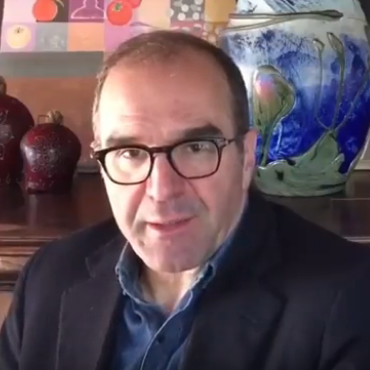
by Wine Owners
Posted on 2016-06-08
Remember spring 2011. In Bordeaux there was an early April heatwave, that added to the feel-good factor felt by producers and merchants alike. All agreed, this was a golden age for Bordeaux.
The wealthy were getting wealthier, raiding the post–Lehmann EU Agricultural Support Fund, citing 'agriculture' status so that they could construct new chais. It seemed taking the piss had become institutionalized.
By the late summer, barely 4 months after that balmy spring, it was over. The bubble had burst, but not before the world and his wife had piled into overpriced Classed Growths.
Fast forward 5 years, and the negative market sentiment created by those purchases by traditional and new En Primeur buyers has all but dissipated. The good news is those who were deeply under water on the back of 2009 and 2010 purchases are now in the shallows and feeling rather more positive about their purchases and their outlook.
This has been helped by the fact – there, I said it, by the FACT - that there hasn’t been a vintage to touch those two monumental years since. Not 2011 and 2013 of course, neither 2012 nor 2014, and surely not 2015 either. To be a great vintage Bordeaux needs to be uniformly wonderful across its communes, and 2015 was far from uniform. It’s a very good vintage overall, but not a great one. It will not join the pantheon.
The prime reason why Bordeaux suffered so badly over the period 2011-2014 was negative sentiment, and nothing fuels negative feelings like losing money on paper.
It is for that reason 2015 may well prove to be a watershed in the history of En Primeur.
Many Chateaux released at realistic prices that made their wines sensible buys – wines like Pape Clément, Rauzan-Segla and Canon, Leoville Barton, Pontet Canet, even Lafleur and Tertre-Rotebouef.
More Chateaux than not released too high. What do we mean by “too high”? After all, it’s a relative term. Our definition of too high is a price that will prove not to give a discount against future market value or which could end up having been more expensive than the future discounted secondary market value in 2-5 years’ time.
In the last few days, a few Chateaux have pushed the boundaries of credulity, releasing wines at such a high price that there is 90%-99% downside attached to buying early.
Wines such as Pichon Baron, Lynch-Bages and Palmer. As the graphs show, none offer much by way of upside and plenty of downside risk.
None of this matters to the informed, rational fine wine buyer. They simply need to say ‘no thanks’ and move on, selecting affordable back-vintages to enjoy, lay down for future drinking, or to use as a store of value.
What does matter is when less well-informed buyers are badly advised and sold into the vintage’s more expensive releases, only to find out a few years down the line that the wine has fallen in value, those losses further exacerbated by broker commissions. If you end up with enough buyers “under water” goodwill built up painstakingly over time evaporates.
In this campaign some merchants are saying things like:
Qualitatively, 2015 has been compared to previous greats of this century - 2010, 2009, 2005 and 2000 – when looking at price compared to these greats, the wines of 2015 have broadly represented good value with most estates benchmarking against these years and releasing at lower prices – which is quite refreshing.
Not only is the premise wrong, it encourages irrational buying behavior based on unrealistic expectations and stores up future negative sentiment.
This is a shame, for Bordeaux has the greatest, largest single body of wine in the world to offer. The greatest expressions should bring the greatest joy, not deliver disappointment.
by Wine Owners
Posted on 2016-05-10
Have the Bordelais got it right this year? So far so good. The campaign is a little over a week old, the phoney war is over, and we're into the first wave of releases worth bothering with. I'll put money on the campaign being over by the time UK goes to the polls to vote for or against EU membership.
Let's have a look at some key releases to date, through the looking glass of price per points analysis, with the important overlay of commentary about the wine.
So far these offers are reasonably appealing. This surely recognises that this is not a vintage that has hit the heights of 2010 and 2009, nor has it the across-the-board homogeneity of the serious, intense 2005s, in my opinion. But the best wines are not far off the great vintages and there's a finesse, silkiness, aromatic quality and allure to the best wines that makes them fine in their own right.
Lafleur 2015
Looking tempting in a high class sort of way. Beloved by many in 2015. Called by some as wine of the vintage. We thought 2015 was a Cabernet Franc and Petit Verdot vintage, whatever the experts said about the quality of Merlot. We thought the variability of the earlier ripening Bordeaux grape, touched by the extreme heat of July's dog days, was such that it couldn't be called out as an overwhelming success. Where the ripeness was managed and the Merlot was brought in with enough residual freshness it was good. Where it was partnered with a high proportion of Cabernet Franc, we thought the wines were simply beautiful.
At £2,250 for 6x75cl it might seem eye-waveringly expensive, but remember this isn't much more than Le Pin 2004, and this is surely as extraordinary and visceral.
The only comparative question mark on the horizon is the price of 1998 (such a great vintage in Pessac and the Libournais) yet this vintage was tannic and backward, a wine for the next generation or the one after that, whereas 2015 is all about its silkiness and appealing ripeness.
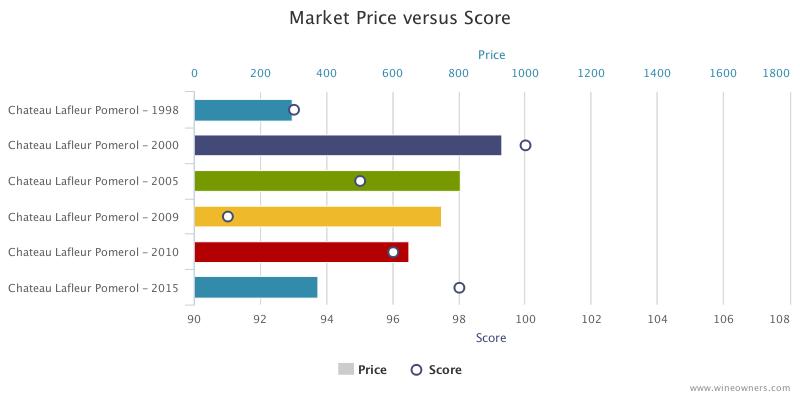
Chateau Pape-Clément 2015
We normally dislike Pape-Clément, but this was a great wine in our view this year. Worth buying early? Have they got the price right this year? Yes if you compare to the great back vintages of the last 10 years, not if you draw equivalence to the highly rated 2012. Neal Martin's note on this wine corresponded exactly with our own, so here it is:
The 2015 Pape Clement is a blend of 56% Cabernet Sauvignon, 40% Merlot and 4% Cabernet Franc. It was cropped at 40 hl/ha between 25 September and 15 October with berry by berry destemming. It has a drop-dead gorgeous bouquet that continues the ever greater finesse that has been imparted into this Pape-Clément in recent years. It is extremely precise, almost crystalline. The palate is underpinned by fine tannin, pitch-perfect acidity, a sense of cohesion and harmony that is outstanding. There is not a hair out of place on this barrel sample and it will doubtless evolve into one of the best wines this state has produced since the 14th century, when Bertrand de Goth was planting its first vines. This comes highly recommended - a Pape-Clément that will reward those who can resist temptation and cellar this wine for 10+ years. Tasted on four separate occasions.
Chateau Beychevelle 2015
Delicious mid palate, balance uber alles and a nice bright finish. Reminds me of the '14s in its un-extracted style. Would I buy this early? If I wanted to drink it a decade down the line it might well make sense.
by Wine Owners
Posted on 2016-05-09
As we jump into the 2015 En Primeur campaign with analysis and our recommendations of those wines that could be worth buying early on, let’s have a look at how last year’s 2014 En Primeur ‘picks’ have performed.
We used our price per points analysis to identify relative value of the 2014 releases vs comparable back vintages vintages
It's worth noting that wines that we felt could have been worth buying early were a little more than a handful, out of the swathe of en primeur releases. But then, there are only about 60 wines potentially worth bothering with these days. Buying the equivalent of cru bourgeois releases as a future is surely a mug's game these days. Of the 60 or so top producers who released in 2014, we thought there were about 8 wines worth buying as a future.
Here's how they performed...
Chateau Lafite Rothschild 2014
Last year you could have bought a 12x75cl case of Château Lafite Rothschild 2014 for £ 2,700. Since then, it's increased to £3,300 (12x75cl) which represents a growth of 18% from it’s initial released price.
It was a tough one to taste at the property in April 2015, but we took a punt on it as proper wine - at least there was no lipstick applied to the barrel samples.
Chateau Calon Ségur 2014
Released at £410-£420 (12x75cl) retail, Calon has increased in price by 23.2% and stands at a market price of £505. It's worth noting volume of wine released En Primeur was much reduced last year and négociant channels were heavily rationalised. Having been earlier acquired by new owners for €200M, expect further 'management' of En Primeur releases in an attempt to drive the secondary market price.
Chateau Margaux 2014
The release price of Chateau Margaux 2014 was £ 2,340 (12x75cl).
Market price has risen to £ 2,850 for a case of 12 in one year, and increase of 21,8%.
Robert Parker Score : 93-95
Petit Mouton 2014
Le Petit Mouton’s release price was £ 750 per case of 12 bottles, the closest thing to a ‘one way bet’ we found last year, and I filled my personal boots. Given how well this atypically predominant cabernet Sauvignon Petit Mouton has performed in the last 12 months, we hope you did too! It was also the most delicious and impressive wine, and felt to me a little under-rated by Neal.
The price of Le Petit Mouton has increased by 30% going from £ 750 to £ 1,080 for 12x75cl.
Robert Parker Score : 90-92
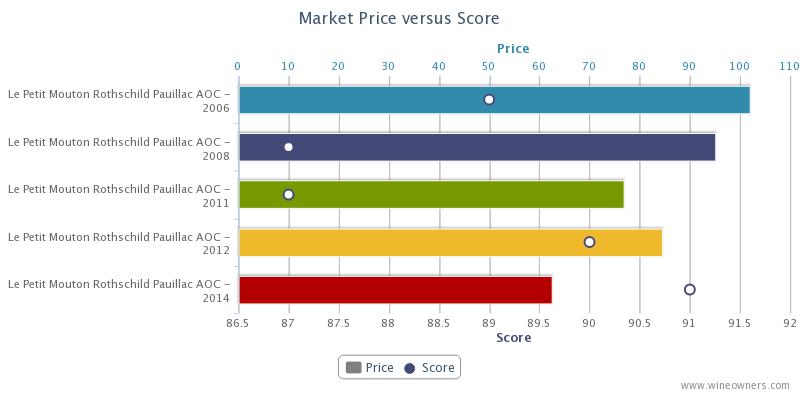
Chateau Mouton Rothschild 2014
Along with Petit Mouton, we loved Mouton last year, with its merlot so successful on gravel that a large slug of it made it into the Grand Vin. The trade was baying for release prices close to 2008 (£1750-£1800), but we thought £2,300 was a fair price for the quality, especially in the light of how much market momentum there has been behind Mouton of late.
Mouton 2014 has increased from it’s release price to £ 2,700, an increase of 13%.
Robert Parker Score : 96/100
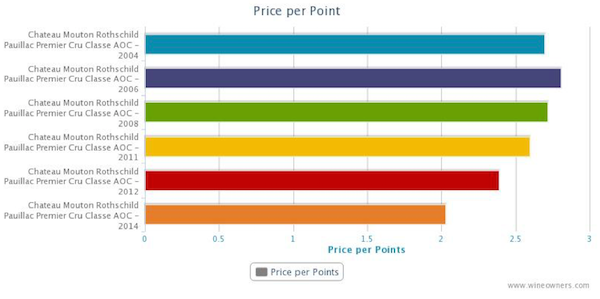
Chateau Lynch-Bages 2014
Chateau Lynch-Bages 2014 was universally declared good value by the wine trade last year, and released at £580.
Over the past year it rose from £ 580 to £ 650 (12x75cl) representing an increase of 12%.
Robert Parker Score : 92 -94

Chateau Canon 2014
This stood out as proper wine last year as well, and tasted alongside some heavyweights held it's own. Re-tasted this year, it's shutting down and wasn't the most exciting wine on earth. The price hasn't budged either way from its release price of £375. One that in retrospect we should not have recommended to buy early.
by Wine Owners
Posted on 2016-04-07
When asked by a French journalist if he thought 2015 was an antidote to the Bordeaux fine wine market 'bashing' of certain journalists, Monsieur Rolland let fly:
“There’s no cure for imbecility - it's reaching colossal proportions. For me, 2015 is a truly great vintage. There are too many idiots to notice. They’ll figure it out in 10 years’ time, as usual. We live in a world without gumption; with people without balls. End of story. There isn’t a journalist who's seeing it. Anyway, there isn’t a wine writer with any substance in the world today. I don't give a damn about what journalists say. That has nothing to do with the market. They can say, write and think what they want; the world won't give a hoot, just as it doesn't care what happened in 40 AD! (from the idiom 's'en foutre comme de l'an quarante' - a year which had been predicted as the end of the world). When they realise that, maybe they’ll eat humble pie. Not that they’ll become intelligent - that will be difficult - but maybe they'll learn to think differently.”
by Wine Owners
Posted on 2015-05-27
What will it take for consumers to buy 2014 en primeur? The vintage produced many very good wines, but it isn’t another vintage of the century. Whilst it is a vintage that is qualitatively superior to any of the preceding years 2011-2013, the wines are heterogeneous; it is therefore a vintage to buy selectively.
Many producers were not keen to compare 2014 to 2008, which does nonetheless seem to be its closest benchmark if one had to only select one vintage. There is freshness across the board, and when combined with the vintage’s inherent fruitiness, has resulted in many appetising wines with substance and character.
Some, such as Chateau Latour, did compare 2014 outright with 2008, and perhaps it’s little coincidence that they do not need to sell this vintage, given their withdrawal from the en primeur release schedule. Others pointed to the pretty, succulent nature of the vintage (at its best), reminiscent of 1983 crossed with the structure of 2008.
Looking at it purely from the consumer’s perspective, they are most likely to buy if this vintage is priced to a discount of around 20% versus current low market 2008/ 2006 prices. Here’s why:
1/ There are only two reasons to buy early: scarcity and price. Since scarcity is merely a relative term in Bordeaux where quantities produced are generally substantial, that leaves price.
2/ The consumer has traditionally played the role of stockholder for en primeur releases. There is no reason to assume the risk of tying money up early, losing its opportunity cost, and incurring storage charges unless there’s a strong financial reason to buy up front.
3/ 2014 is qualitatively at least as good as 2008 or 2006. Pricing en primeur using the last vintage as a benchmark is meaningless. Producers want to price the current vintage to a meaningful premium over the very poor 2013s, because it is much better. Merchants want the Bordelais to price to the same price as 2013 to win back confidence. Neither side is focusing on the correct data.
Much more meaningful is comparing to current market prices of vintages that are qualitative benchmarks, hence picking 2008 and 2006 best market prices as the basis for showing what consumers need to spend for a comparable level of quality.
So using Wine Owners’ Market Level pricing data for First Growths and our favourite wines this year, we’ve calculated, based on a 20% discount to current or recent best market prices for 2008 and 2006, what we think consumers should be paying in £ sterling for a 12x75cl In Bond case of 2014 en primeur.
Because prices fluctuate, we’ve taken market pricing from 3 months’ ago and also from this month’s market pricing of 2008 and 2006 vintages, and have taken the highest average of the two vintages sampled from 3 months’ ago and this month.
Based on this analysis we’ve calculated suggested £ sterling prices to consumers, inclusive of margins taken by the whole channel of distribution including merchants. These suggested 2014 en primeur prices sample only the First Growths and those wines tasted that we liked the most.

Related articles:
2014 Bordeaux – The Vintage
Post Parker Primeurs
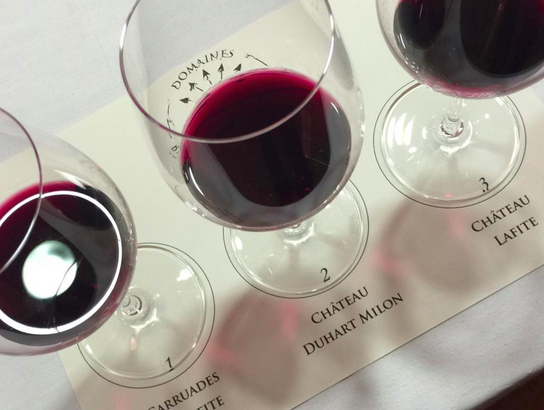
by Wine Owners
Posted on 2015-05-22
There are some beautiful wines in 2014, a vintage that (at it’s best) is qualitatively superior to any of the preceding years 2011-2013. On the other hand, it is not a 2000, 2005 or 2010. The vintage is heterogeneous; it is not therefore not recommended to buy broadly, and demands research into the best wines.
Most successful will be those producers who didn’t over extract. At Calon Ségur they summed it up with ‘everything had to be soft this year’ (to make great wine). Those who tried hard to push the possibilities from the available grape must will have run the risk of having made unlovely wines.
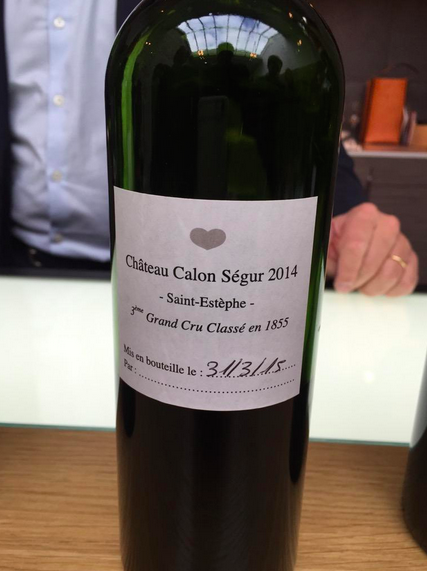
In Pessac-Leognan and the Libournais, in those cases where wines were rather more extracted, it seems to have resulted in sharp wines with bitter, tinged-green tannins. According to one producer this is due to the phenolic maturity of the grape pips. Consequently these were my least favourite sub-regions this year. In the blue-chip appellations of the Medoc peninsular, the wines were more homogeneous (with the exception of the generally unpleasant Haut Medocs), and in the communes of St. Julien, Pauillac and St. Estephe the year was a success.
At its best it will be a fine, classic vintage of wines that will give medium+ term pleasure. At its worst there will be wines that are angular, sharp and of questionable balance.
Many producers were not keen to compare 2014 to 2008, which does seem to be its closest benchmark if one had to only select one vintage. There is freshness across the board, and when combined with the vintage’s juicy fruit, has created appetising wines with substance and character.
Some, such as Chateau Latour, did compare 2014 outright with 2008, and perhaps it’s little coincidence that they do not need to sell this vintage, given their withdrawal from the en primeur release schedule. Others pointed to the pretty, succulent nature of the vintage (at its best), reminiscent of 1983 crossed with the structure of 2008.
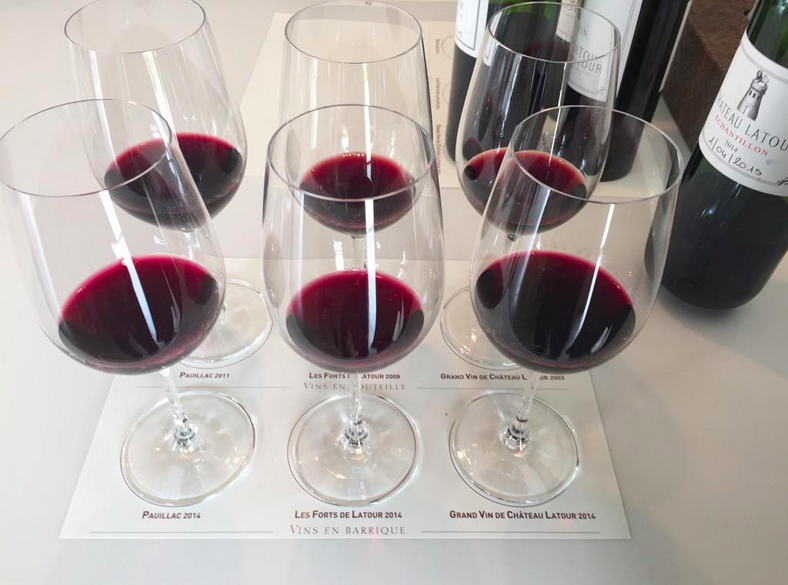
This was a late vintage, the summer was dreadful but the autumn was dry and sunny; a perfect Indian summer allowing producers to pick more or less at their leisure. There’s a saying that ‘ Août fait Le Moût ‘ (literally August makes the must – meaning the quality of a wine is forged by the August sun). This is typically when véraison takes place (the period during which the colour of the grapes change to their harvest colour). That wasn’t the case this year: the summer was poor and August cold. The prolonged, sunny autumn of much warmer than average days and cool nights made up a good chunk of that phenolic maturity gap, but did it completely totally compensate? Not entirely across the board it seems.
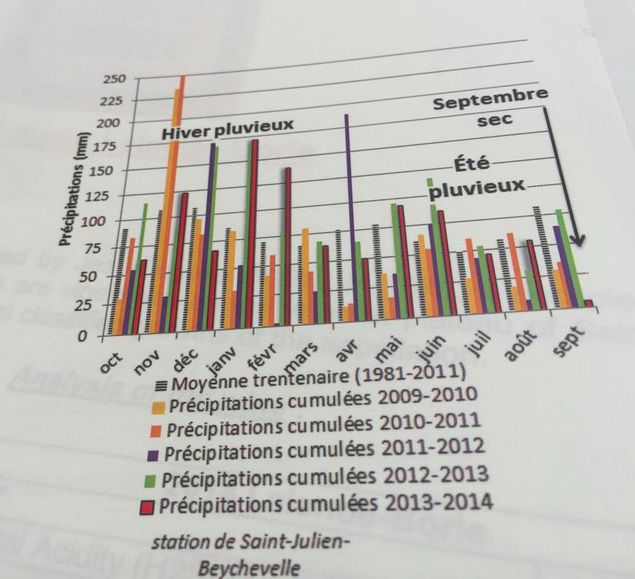
Two grape varieties that seem to have outperformed this year were Cabernet Franc and Petit Verdot. These varieties appear to exert disproportionate influence over the character and complexity of wines in 2014, belying the small proportions they generally contribute to Bordeaux blends. Conditions in 2014 enabled both these varieties to be picked at optimal maturity, subject to the soil composition on which they are sited.
If the Chateaux price to within a few percent of their 2013 releases, it is expected that the better wines will sell en primeur in April or May due to the weakened euro, especially versus the dollar.
Looking at it differently, consumers are most likely to buy if this vintage is priced to a discount of around 20% versus current low market 2008 prices. Here’s why:
There are only two reasons to buy early: scarcity and price. Since scarcity is merely a relative term in Bordeaux where quantities produced are generally vast, that leaves price. The consumer has traditionally played the role of stockholder for en primeur releases. There is no reason to assume the risk of tying money up early, losing its opportunity cost, and incurring storage charges unless there’s a strong financial reason to buy up front. That traditional purchase proposition is compounded by the losses consumers are sitting on in respect of the 2009 and 2010 vintages and certain 2006s.
If producers push the price increases further, ignoring the personal and behavioural economic reasons why consumers buy (because it’s a better vintage than 2011-13) there will be even less reason to buy these wines early. And that will be have been an opportunity missed to positively influence sentiment towards Bordeaux.
Nick Martin
